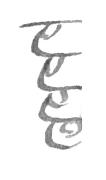From J. J. Weir 31 March 1868
6 Haddo Villas | Blackheath SE
31 Mch 1868
My Dear Sir
As you infer the ♂ chaffinch approaches the captive singing bird from sexual rivalry, in “Pegging”.—1
Chaffinches have stations which they occupy during the breeding season, and are all day busy singing or making the noise Pink-Pink, Pink-Ping—
I am afraid I have led you into error about the Linnets, in the early part of the season being mostly females, the season I speak of commences in September this month & the following are the great months for birdcatchers.2
I have been again to examine the Pavo nigrissimus & find there is not the shadow of a doubt that it is the bird formerly pure white, it is known by the middle toe having been taken off by a trap when very young.—3
My friend had 7 others all of the common variety.—
You can if you like send my letter to Wallace but I propose to make more experiments this Summer & shall probably write a paper on the subject.—4
My observations are not complete because up to the present time I have not been enabled to get the brightest colored perfectly smooth larvæ.—
You ask whether I have a theory about the loss of one of a pair of birds being so quickly repaired?5
I have thought very deeply on this subject but have not yet arrived at any satisfactory conclusion.—
The mortality of birds is very great, but whether the check is continuous over the whole year or not is difficult to say.—
A friend of mine at Brenchley in Kent has a post on the top of which, for 40 years or more, a Muscicapa griseola6 has built a nest; this has been always preserved yet there still arrives but one pair, this is not a persecuted bird but what becomes of the 5 young produced each year?—
In a similar case at Pembury7 I think two pair returned one year but one pair ejected the other from the nest, for I found one nest built over the other and each contained eggs in a fresh state.—
My friend adverted to preserves the birds round his house which was built by his Grandfather, and the Swallows (Hirundo urbica)8 have increased, their nests are now in some parts four deep, thus—

I have watched carefully the progress of a Rookery from my windows at Blackheath for ten years.—
There were no rooks prior to 1858, but in this year the nests were five in number, the birds were not shot and I thought that there should have been from ten to fifteen nests next year but there were not more than 6 or 7, the addition has been about one or two nests per annum & the number now is 25, last year I think I counted 22, this latter would have produced at least 100 young even if but one nest was hatched by each old pair, and as I cannot find that more than one bird was shot, there should have been an increase of 50 nests but the actual increase is but 3.—9
I have further noticed that weeks after other rooks have made their nests & have begun to sit, some more nests are suddenly built and occupied, as if pairing had but just commenced.—
The question naturally arises what becomes of all these rooks? they are very wary birds, they are rarely if ever killed by Falcons, they are never seen to die, indeed during all my life I have but once seen any bird die naturally ie in a wild state & have never picked up a dead bird unless shot & but twice have seen in a wild state a bird with disease & in one of these cases it was very trifling.—
May it not be more difficult than we imagine for birds to obtain partners?, and is it not possible that there may be many unpaired birds?—
I may observe in conclusion that rooks at Blackheath have quite altered their habits from country rooks, they rarely appear in flocks but are seen all over the Heath in parties of two or three, they are so tame that they will come into the gardens for pieces of bread.
Believe me | My Dear Sir | Yours very sincerely | J Jenner Weir
C Darwin Esqre.
CD annotations
Footnotes
Bibliography
Weir, John Jenner. 1869. On insects and insectivorous birds; and especially on the relation between the colour and the edibility of Lepidoptera and their larvae. [Read 1 March 1869.] Transactions of the Entomological Society of London (1869): 21–6.
Summary
Sexual behaviour of chaffinches.
Numbers of female linnets in September.
His experiments on brightly coloured larvae [as food], testing A. R. Wallace’s theory.
His observations of a rookery make him wonder whether it may not be more difficult than we think for birds to pair.
Letter details
- Letter no.
- DCP-LETT-6074
- From
- John Jenner Weir
- To
- Charles Robert Darwin
- Sent from
- Blackheath
- Source of text
- DAR 46.1: 98–101, DAR 84.1: 69–70
- Physical description
- ALS 12pp †
Please cite as
Darwin Correspondence Project, “Letter no. 6074,” accessed on
Also published in The Correspondence of Charles Darwin, vol. 16


